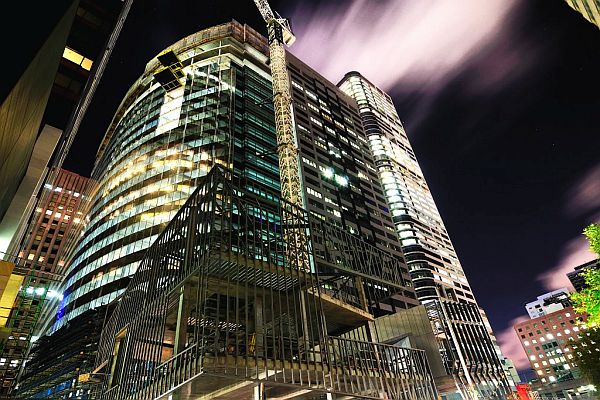It was during my first visit to London, in 2011, that I finally felt like an Aussie. After a picturesque rail journey from Glasgow to Kings Cross station, I was in shock when confronted with the crowds, and not happy about lugging two suitcases up several flights of busy staircases. There was further affective congestion to come as I stayed in university accommodation near Oxford Street, took the packed tube to be a tourist and see friends, and struggled to enjoy walking on the hustling streets. My privilege as someone living in a riverside Brisbane apartment at the time, and accustomed to a great deal of public space, was only just becoming manifest.
In light of this distant encounter with congestion, I should probably have the capacity to empathise with recent accounts of over-populated chaos in my own city, which now happens to be Sydney. ‘Affective congestion’, as I experienced it in central London, was merely a higher density of people, vehicles, and buildings than I was accustomed to in urban Australia. However, the way this discourse is being deployed in the current state election campaign in New South Wales reflects an emotive politics that amplifies public concerns, but selectively and with the wrong emphasis. Not only are new migrants with scant resources being scapegoated in diatribes about ‘over-population’, but they are also a convenient distraction for a government that has fast-tracked development without planning for adequate infrastructure.
In late 2018, Premier Gladys Berejiklian declared: ‘I would be irresponsible if I did not identify the issues that matter to our communities. People are concerned about the character of their environments, people are concerned about their quality of life moving forward, and so am I’ (my emphasis).
While her comment conflates population growth with environmental sustainability, is it not clear just who is voicing this concern, why they are feeling anxious, and what the state and federal governments plan to do about it other than slowing the migration intake. Just a fortnight before the polls, both parties have announced different sets of plans for tackling congestion on roads. While Labor promises that motorists will get their tolls back, the Liberal Party is offering free registration to regular toll road users. What remains to be seen is how this will resonate with voters in the most economically disadvantaged parts of Sydney, which often have the longest commutes to and from work.
The issue of congestion is also impacting the looming federal election. Until September last year, Prime Minister Scott Morrison dismissed any suggestions that the permanent migration numbers needed to be cut to control population in the major cities. Then came a major policy backflip as Morrison started claiming there was uneven population growth across the big brown land. By December, the federal treasurer was meeting state and territory treasurers in Canberra to discuss congestion and population growth. This was largely an opportune occasion for the Morrison Government to unveil its new $19 million ‘regional visa’ plan for potential permanent migrants. This was presented as a win-win: Sydney, Melbourne and south east Queensland will get some room to breathe, and regional areas will get to boost their economies and fill job vacancies.
What interests me in this narrative is the explicit linking of over-population to seemingly legitimate concerns about the environment, when the implicit policy directives often scapegoat new and future migrants. It is this group on whose behalf others can make life-changing decisions; it is this group that is deemed too desperate to enter or remain in Australia; it is these bodies, and their presence on our clogged roads, their odours in our crammed trains that are perceived to be excessive to our cities, even as economists highlight how reliant we are on the annual skilled migrant intake for GDP growth (a narrow utilitarian focus I critiqued in this magazine last year).
Is there a discernible difference between the feelings of congestion evoked for those perceived to be essential to our nation, and those who arrive and live in the most congested conditions, largely for reasons of affordability? Does it produce not only anxiety for the former group, but also nostalgia for what has been lost and is at risk of further loss? Or is congestion a momentary affect that comes from bumping into someone on a train and is multiplied as a result of media and political frenzy?
To be fair, some political commentary and media analysis usefully highlights the importance of long-term infrastructure planning, and how Sydney and Melbourne lagged behind on this front in the early 2000s relative to projected growth. Likewise, the Victorian Labor government has raised objections to the regional visa program, suggesting that the funds being invested in it would short-change infrastructure funding. The chairperson of the Federation of Ethnic Communities Councils of Australia (FECCA) has welcomed the creation of jobs in regional areas but added that ‘governments have to be far more visionary in planning for the future.’
Given that the last major backflip on population policy – by former Prime Minister Kevin Rudd –was triggered by unfavourable opinion polling, one ought to remain skeptical of whether it is amplified sentiment or measured evidence that informs the planning agenda. More balanced economic and demographic perspectives on the matter need to be encouraged and disseminated in the media, but it is unlikely that facts alone can fan away the anxious heat of affective congestion.
Polling on this issue is indicative, yet selectively presented. An article in the Australian Financial Review from the end of last year began with a quote from a commuter in Parramatta – the heart of Sydney’s western suburbs – who is married to a Lebanese man and thinks the place is over-populated. This was followed by the analysis of a Fairfax poll which concluded that most Sydneysiders don’t want more migrants or further development. What was not clear from this sampled polling is, once again, who are these people that fear congestion? Perhaps the anecdote of the harried commuter in a domestic partnership with a migrant was meant to assuage concerns about the veiled racism of those attributing congestion to excessive migration. Still, where is the invisible-but-always-too-present migrant here?
To make some progress in this debate, it is vital for politicians and the media to acknowledge that they are conflating largely white middle class concerns with the anxiety of the ‘wider community’. Why is this unsayable? It is likely that recent migrants and former refugees matter less in political terms, are seen as less likely to mobilise to save their suburbs from over-development (as citizen-volunteer groups have done in my suburb of Marrickville, or politicians with a say are doing in councils like Ryde). What is equally vital to point out here is that the government now advocating for cutting permanent migration is also the very same one that has fuelled frenzied building developments – often over-priced or poorly-planned – in parts Sydney and Melbourne. So, while ordinary people from different backgrounds might be rightly concerned about the pace of construction, and too many cranes and road blockages in their neighbourhoods, they are being wrongly encouraged to point the finger at migration.
This still leaves questions unanswered about the specificity of the feelings and actions of particular groups, such as non-white migrants in western Sydney who arrived more than a decade ago – before the building and real estate boom – and are now relatively privileged in socio-economic terms. Why are they not hiring community spaces on the weekend to hold meetings to resist opportunistic developers? We have to acknowledge that for a range of reasons – ranging from economic security and conditions in the respective home-countries to lack of civic participation beyond the ethno-linguistic group – this demographic may not actively oppose over-development. In suburbs like Footscray in Melbourne, there are some instances of second-generation migrants actively facilitating gentrification through food and retail businesses, as well as property development.
The question, then, is to separate the celebration of cultural diversity that migrants are seen to bring from a more nuanced understanding of their economic motivations and behaviour. The state, after all, cares less about their feelings regarding congestion and much more about their productivity. How can their political participation be facilitated?
And finally, what do the original custodians of this land make of this affective politics of congestion? Are we too scared to ask them in a climate where even the Uluru statement does not get a hearing? In their study of a rapidly changing southern Sydney in 2009, Bloch and Dreher pointed out that ‘it is imperative that investigations of place-sharing do not simply reproduce the original and ongoing dispossession of Indigenous ownership and belonging, but rather centre Indigenous knowledges of home and place. ’ Similarly, in their recent work on re-imagining Parramatta, Barns and Mar highlight how the area may have been used as a gathering place for at least 5,000 years, and its narrative of ‘waves of migration’ needs to be foregrounded amidst the thicket of new towers.
As I attempt to get to work before 9:30am on the Illawarra line, or leave my office in Liverpool – in Sydney’s south-west – and get stuck on the M5 in peak hour, I wonder whether the affective power of congestion gets more powerful when we are moving, working, and trying to be good economic citizens. It might be more pleasant to commute in off-peak hours but it is often not possible for those bound by workplace meetings or childcare structures beyond their control. What I do know is that the crane emerging from the relics of a long-gone corner store at the end of my street is not due to an influx of migrants.
Image: Flickr



